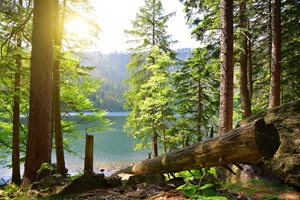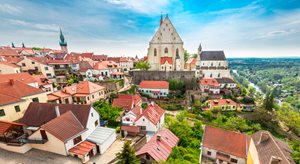The Iron Curtain. The Cold War. The communist East and the capitalist West. We have not heard these words in news reports for 30 years, and yet for half a century they represented the everyday reality for millions of people. The Iron Curtain stretched across Europe from the north to the south. And it was not only the symbol dividing the ‘East’ and the ‘West’: it physically existed as a strip of uninhabited and heavily guarded territory with barbed wire in the middle. Do you want to know where it was? Today you can peacefully take your bike and set off on a journey through the area that cut through Europe!
A Unique Cycling Trail
 The Iron Curtain Trail is a cycling trail that is almost 10,000 kilometres long. It is marked in maps as EuroVelo 13. The Czech part of the cycling trail leads from Aš in West Bohemia along the Czech and Austrian border to the confluence of the Dyje and Morava rivers in the southeast corner of Moravia. Its goal is to link European history, culture, and nature with sustainable tourism.
The Iron Curtain Trail is a cycling trail that is almost 10,000 kilometres long. It is marked in maps as EuroVelo 13. The Czech part of the cycling trail leads from Aš in West Bohemia along the Czech and Austrian border to the confluence of the Dyje and Morava rivers in the southeast corner of Moravia. Its goal is to link European history, culture, and nature with sustainable tourism. A Detour to a Spa
In the Czech Republic, this cycling trail leads through the royal town of Cheb where there is a monument in honour of the victims of the Iron Curtain: the Svatý Kříž Memorial. You can take a detour during your trip and visit the spa towns of Františkovy Lázně and Mariánské Lázně. The medieval castle of Loket, with an especially good local microbrewery, is also along the way.Through Šumava to Český Krumlov
 The cycling trail continues to the area of the Šumava National Park, where you can also find a few memorials commemorating the Iron Curtain, in addition to the beautiful and unspoiled nature. For example, there is a memorial in honour of the Czech and German citizens who helped people cross the international border in Kvilda. The memorial is near a wooden bridge across the Teplá Vltava river, the river crossing used by escapees. Šumava was a place where the citizens of Communist Czechoslovakia secretly emigrated to the free ‘West’.
The cycling trail continues to the area of the Šumava National Park, where you can also find a few memorials commemorating the Iron Curtain, in addition to the beautiful and unspoiled nature. For example, there is a memorial in honour of the Czech and German citizens who helped people cross the international border in Kvilda. The memorial is near a wooden bridge across the Teplá Vltava river, the river crossing used by escapees. Šumava was a place where the citizens of Communist Czechoslovakia secretly emigrated to the free ‘West’.The trail continues to the Šumava Cycling Route, recently completed and offering many kilometres through never-ending forests and pastures, dozens of former settlements, and villages. Many of them ceased to exist due to the border protection and impenetrability of the Iron Curtain. This major cycling route is 163 kilometres long and follows regular as well as back roads.
When you cross Šumava, you will cycle along the Schwarzenberg Floating Canal, followed with a descent to Vyšší Brod, which is home to the only functioning male Cistercian monastery in the Czech Republic. If you have the time and energy, take a detour farther into the Czech Republic: Český Krumlov and the Třeboň Region are very close.
Off to the Wine Region!
 From South Bohemia, just past the Renaissance town of Slavonice, there is Moravia, a historic region where the trail continues. The terrain and the landscape are friendly – there are no high hills to climb, and there are wine cellars around every bend. When you enter the Podyjí National Park from Hardegg in Lower Austria across the restored bridge, you will get to the visitor centre in Čížov, where you can check out 350 metres of the preserved original Iron Curtain, including a guard tower. From Podyjí, the road will take you to an important historic and vinicultural centre along the trail – Znojmo. The sad history of the 20th century in Europe is documented by dozens of bunkers and forts built to protect Czechoslovakia from Nazi Germany before WWII.
From South Bohemia, just past the Renaissance town of Slavonice, there is Moravia, a historic region where the trail continues. The terrain and the landscape are friendly – there are no high hills to climb, and there are wine cellars around every bend. When you enter the Podyjí National Park from Hardegg in Lower Austria across the restored bridge, you will get to the visitor centre in Čížov, where you can check out 350 metres of the preserved original Iron Curtain, including a guard tower. From Podyjí, the road will take you to an important historic and vinicultural centre along the trail – Znojmo. The sad history of the 20th century in Europe is documented by dozens of bunkers and forts built to protect Czechoslovakia from Nazi Germany before WWII.There is plenty more that you can’t miss in South Moravia. Take the scenic town of Mikulov, for example! In addition to its wine cellars, you should also visit the Freedom Trail, which tells the stories of people who tried to cross the Iron Curtain. When you leave Mikulov, the trail continues to the Lednice–Valtice Protected Landscape Area, registered on the UNESCO World Cultural Heritage List. The history of the Iron Curtain is documented in the Valtice Museum, established in what was once a customs office. The Iron Curtain Trail, EuroVelo 13, then leaves the Czech Republic near the confluence of Moravia’s two largest rivers – the Morava and the Dyje – near Břeclav.











-(1).jpg?width=1920&height=1204&ext=.jpg)